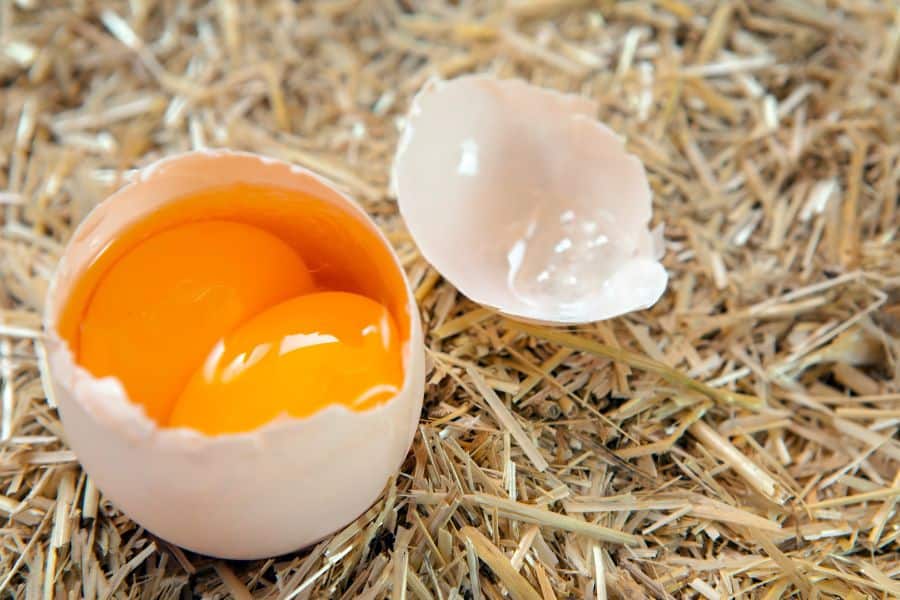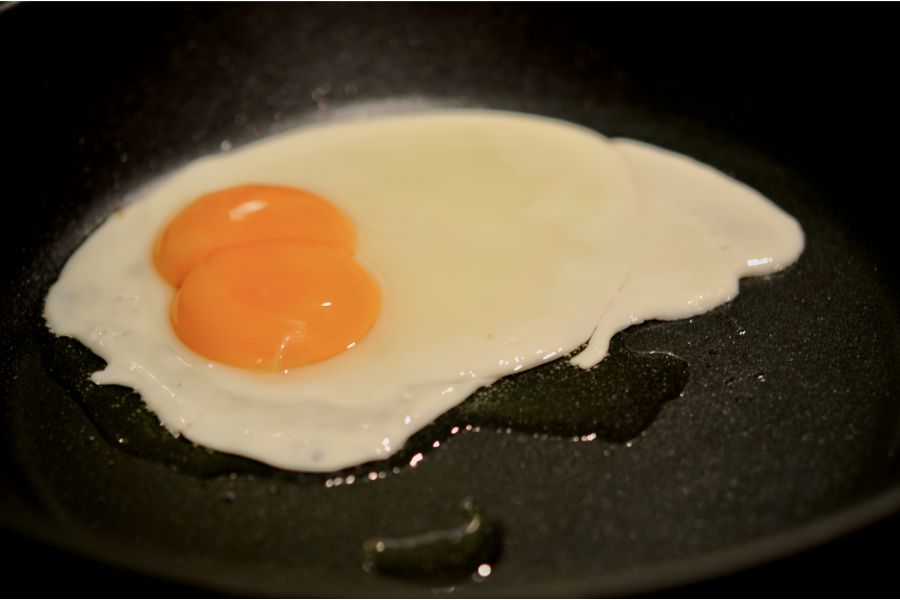Finding a double yolk egg in your egg carton is certainly a rare and pleasant surprise, but you may want to know a bit more about these eggs before you decide to consume them.
In this article, we’ll be going into detail on what exactly are double yolk eggs, how they form, whether it’s safe for you to consume, and much more.
Double yolk eggs are eggs that contain two yolks in the same shell, which usually occurs as a result of rapid ovulation in young hens.
These relatively rare eggs, which occur in about 1 out of 1000 eggs, can potentially hatch two chicks (if fertilized) and are safe to consume, though they probably won’t bring additional nutritional value.
Before discussing double yolk eggs, let’s first go a bit more into the anatomy of regular single yolk eggs and how they’re formed so that what comes after makes more sense.
What Does a Typical Egg Consist Of?
Eggs that are consumed by people are typically unfertilized, meaning they’re unable to produce chicks.
Nonetheless, they contain many of the same components as fertilized eggs, such as the shell and shell membrane, egg white, and yolk.
The Eggshell and Shell Membrane
The eggshell and shell membrane account for roughly 10 percent of the egg, and their function is primarily to protect the inside of the egg from all sorts of physical damage and microbial contamination.
The shell in particular helps regulate gas and water exchange for the growing embryo, as well as provides calcium for the embryogenesis process.
The eggshell membrane supports the eggshell in providing protection against environmental damage, and preventing the loss of hydration for the inside of the egg.
The Albumen or Egg White
The albumen (otherwise known as egg white) is the clear liquid that surrounds the yolk, and it accounts for roughly 60 percent of the egg. Specifically, the egg white contains a thick albumen, an outer thin albumen, the inner thin albumen, and the chalazae.
Its function is to mainly supply water needed for embryonic development, and act as a cushion to dampen any movements caused by the embryo. The chalazae help maintain the positioning of the embryo inside the egg.
The Egg Yolk
The egg yolk is the yellow insides of the egg, and it accounts for roughly 30 percent of the overall egg. The purpose of the egg yolk is to supply the nutrients needed for embryonic development in a fertilized egg, hence the yolk contains most of the calories, fat, vitamins, and minerals found in an egg.
How are Eggs Made?
Eggs begin development in the ovary of the hen (second ovary is nonfunctional) and takes roughly 24-28 hours to develop fully after travelling through the oviduct.
Forming the Yolk
The yolk of the egg is first created in the ovary and gets ejected into the first part of the oviduct known as the infundibulum. This is where fertilization takes place if the hen were to mate, as the male sperm will travel here and fertilize the yolk.
Forming the Egg White
After 30 minutes in the infundibulum, the egg proceeds along the oviduct to the magnum, where the albumen/egg white is about halfway developed in roughly 3 hours.
Forming the Eggshell
Next, the egg travels to the isthmus, where the inner and outer shell membranes form in roughly an hour or two while the albumen continues its own development.
Finally, the egg leaves the isthmus and enters the uterus, where it’ll remain for the remainder 18 to 24 hours while the outer hard shell develops.
After the entire process is completed, the fully formed egg is pushed through the vagina and exits the body through the cloaca.
What are Double Yolk Eggs?
Double yolk eggs are eggs that contain two yolks inside the same eggshell, and are typically produced by either young or old hens.
It happens quite rarely, so coming across one is sometimes considered a sign of good luck and fortune!
Why Causes Double Yolk Eggs
The causes of double yolk egg production are still unclear, but research has shown that several factors contribute, particularly early production at a young age.
A double yolk egg is formed when a chicken’s reproductive system releases two yolks instead of the usual one during a single ovulation cycle. This can happen when both eggs are ovulated at the same time or when an oviduct gets tighter, thus trapping two yolks.
These conditions are more common in younger pullets and heavy-breed hens. Meaning double yolk eggs are more frequently noticed in younger hens (in their early egg production stages) who also happen to come from high egg-producing breeds.
With this in mind, let’s look at how these conditions come about by looking at several contributing factors: genetics, the age of the hen, nutrition, and light exposure.
1. Genetics
Some hens may have a genetic predisposition to release two yolks simultaneously, increasing the likelihood of double-yolked eggs. The link between genetics and this condition is lower, but certain breeds have been seen to produce more double yolk eggs, including younger Leghorns, Sussex, and Rhode Island Reds.
Double yolk (DY) eggs can also come about because of a hereditary trait. DY is not tied to certain breeds but rather to a specific flock/line of chickens bearing the same ancestry.
Hereditary DY is more so the case when you get double yolk eggs from the same breed in the same flock as compared to zero from other lines of chicken. If a hen comes from a genetic line where double-yolked eggs are more common, she is more likely to lay such eggs herself.
Hereditary traits are great for those who want to breed hens to produce double yolk eggs. It is still an error-filled endeavor but achievable with fuzzy logic.
The reason why it is rare to breed chickens to produce double yolk eggs is that the eggs rarely hatch into two live chicks; this makes it hard to pass down the genes since there are rarely any chickens born by these birds.
Also, double yolks mean a bigger egg which is harder to pass than a single yolk egg. Due to the stress and difficulty of the process, these hens do not lay eggs for very long.
Another genetic factor is the laying frequency. Some hens are more prolific layers and release eggs more frequently than others. That means that the higher the egg production rates then, the higher the likelihood of double-yolked eggs.
2. Chicken’s Age
Age is the biggest predictor of double yolk layers.
That is because younger pullets (less than a year old) that are just beginning to lay are still trying to get into sync with their egg production systems.
Hens stop producing double yolk eggs once they are mature and have settled into normal egg production. This happens when the hen is about 5 to 6 months old.
In the forming of the yolk stage of egg production, tiny strands called ovarian follicles progressively grow and develop to eventually form the yolk. In younger chickens, about 25% of these follicles develop as pairs. That is because the hen isn’t yet mature to regulate follicle growth and development properly.
As the hen ages, the body matures physiologically to create a precise daily ovulation cycle, i.e., adding albumen and shell within 24 hours and depositing the egg before the next ovulation starts.
Another age-related cause is a hormonal imbalance caused by the endocrinal system. Endocrinological development is the hormonal system’s maturity to help correctly regulate hormones across the body, including the reproductive system.
Therefore, younger hens with a less developed hormonal system experience occasional fluctuations in hormones that can cause the release of multiple yolks during a single ovulation cycle, leading to double-yolked eggs.
Also, the genetic predisposition for early or late reproductive maturation can affect whether a young hen will lay double-yolked eggs. Meaning young hens that mature quickly might produce double-yolked eggs more frequently.
3. Nutrition
A hen’s body weight influences its egg production. Hens that are underweight or overweight due to improper nutrition may experience irregularities in their egg-laying patterns.
Also, nutrition that does not favor follicle development is a contributing cause of double yolk egg production.
According to studies, 50% of daily feed intake of ad libitum will restrict the feeding of an egg-laying hen, thus causing a decrease in DY eggs. Therefore, to increase DY egg production, egg layers should be fed ad libitum with higher protein content to increase their production, therefore increasing their chances of producing DY eggs.
In chickens, the heavier the hen, the higher the chances of producing larger eggs, including double-yolked eggs. To reduce the chances of double-yolked eggs, controlling body weight should be a priority; a good place to start is less protein (<16%).
Poor nutrition can also affect hormone levels and disrupt the normal ovulation process.
4. Light Exposure
Levels of light exposure do cause double yolk eggs in hens.
About 2% double yolk eggs are common in pullets who have just reached their sexual maturity for the first time. In a research study from Lohmann Breeders, it was discovered that this rate of double yolk egg production increased with high light intensity caused by increased light exposure during the day.
Light is a major player when it comes to hormonal system development as well as physiological growth. Light stimulates reproductive cycles in egg layers; this is why hens produce more eggs in summer months due to more intense & longer exposure to sunlight.
Ensuring your hens get the right amount of light stimulation during the early stages will help increase/decrease the chances of them producing double yolk eggs.
It is important to note that nutrition and light exposure are contributing factors that promote genetic and age causes of double-yolked eggs. They are only supporting factors. Double yolk eggs result from a hen’s young reproductive system, laying frequency, and hereditary traits from a specific flock/line.
Are Double Yolk Eggs Safe to Eat?
Double yolk eggs are perfectly safe to eat, though they’re unlikely to be significantly more nutritious than a normal single yolk egg. Therefore, if you ever happen to come across one, there’s no need to throw it away!
What Nutrients are in Double Yolk Eggs?
Normal single yolk eggs contain large amounts of vitamins, such as B-12 and vitamin D, as well as lutein, zeaxanthin (which help maintain your eye health), and fat.
They’re also a good source of protein, but you must consume the yolks to reap the full benefits as they contain roughly 40% of the protein in each egg.
Double yolk eggs contain the same nutrients as single yolk eggs, but they’re not exactly double the amount.
In a double yolk egg, the two yolks in the eggshell are smaller than the average yolk, meaning each yolk most likely contains less nutrients than a typical yolk and that a double yolk egg probably contains similar nutritional value as a single yolk egg.
If you wish to calculate the exact nutritional content, you’ll find that a typical double yolk egg contains a similar nutritional value as a single jumbo egg.
Though the nutrients and calorie count aren’t likely to differ much in a double yolk egg, the egg can throw off a baking recipe since the yolk to egg white ratio is different, so be sure to keep this in mind if you do plan on baking.
Are Double Yolk Eggs Healthy to Consume?
Like regular single yolk eggs, double yolk eggs are good for your health when consumed in a modest fashion.
Although egg yolks are known to be naturally high in cholesterol, the cholesterol in these yolks doesn’t seem to actually raise cholesterol levels in the way some other foods do, such as those high in saturated/trans fats.
There’s been superstition that says eating eggs can increase the risk of heart disease, but the reason is more likely to be due to the supplementary foods you consume with eggs (i.e. bacon, sausages, ham, etc.) and the fact that some people may cook their eggs in oil or butter.
The same can be said about diabetes, in which there’s been rumors that eggs can increase the risk of developing the disease. However, no concrete connection has been found and more research is needed to find the connections between eggs, heart disease, and diabetes.
On the contrary, there’s evidence that suggests that eating eggs can actually reduce your risk of heart disease and help modify your LDL cholesterol.
Can Double Yolk Eggs Hatch?
Double yolk eggs can hatch in extreme circumstances, in which case you’ll find two chicks hatching from the same egg.
The likelihood of this happening is extremely small, as even if a fertilized double yolk egg were to be incubated, usually one embryo will outcompete the other for space and nutrients and only that chick will survive until hatching. Most of the time, both embryos will die before hatching.
On the other hand, the likelihood of fraternal twin chicks being hatched from a single yolk egg naturally is most likely zero.
Also Read:
FAQs
1. Are Double Yolk Eggs Rare?
Double yolk eggs are quite rare, with them appearing once in roughly a thousand eggs.
Double yolk eggs are also quite large; hence they’re often categorized as super jumbos, meaning you’re more likely to find them if you regularly purchase large eggs over normal ones.
Its estimated that if you have a flock of roughly 12 mature hens, you can expect approximately 2 double yolk eggs per year on average. As your hens go into old age, the likelihood of getting extra-large-sized eggs, including double yolk eggs, increase.
2. How Many Yolks Can an Egg Have at Once?
As rare as double yolk eggs are, believe it or not there have actually been eggs documented having three or even four yolks. As you might’ve guessed, the chances of these events occurring is even slimmer than those of a double yolk egg.
The record for the most yolks found in one eggshell currently sits at nine!
3. Are Hens that Produce Double Yolk Eggs Genetically Modified?
Hens that produce double yolk eggs are not genetically modified to do so. It’s simply due to chance and occasionally, inherited traits from their parents.
Although the poultry industry has been known to genetically alter the reproductive system of some breeds of hens, this has only resulted in increased egg production, not the likelihood of laying double yolk eggs.
Conclusion
Double yolk eggs can certainly be something you may not expect when buying a carton of eggs from the grocery store, but you should never be afraid of consuming one.
Rather, if you do happen to come across one, you should expect to have yourself a lucky day ahead!


